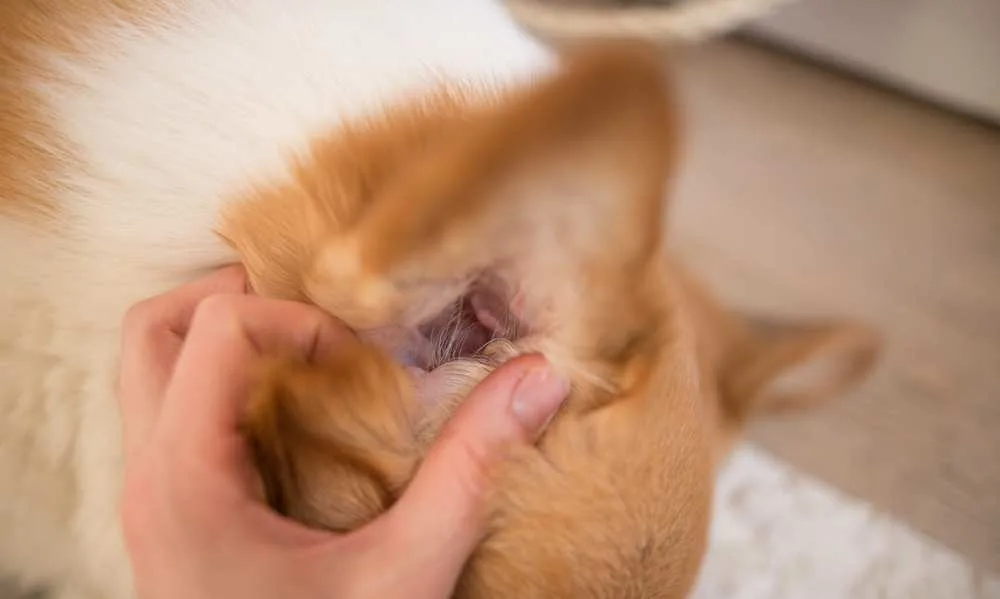Taking care of your corgi means taking care of every part of their body – grooming them regularly, taking health tests from time to time, even checking their ears. If you are a dog owner, you are undoubtedly aware that some dog’s ears require more care than others – infections, taping, etc.
Today, we are focusing on corgi ears. They are not small at all, and they need a lot of care. Ears, just like paws and a nozzle, are delicate body parts that can be susceptible to numerous infections, so we must keep them clean.
Throughout this article, you will learn everything about corgi ears: when do they perk up, do they need to be taped, when do they stop growing, and much more useful information, so stick around!

All Ears
Before going into detail about your corgi’s ear cleaning and everything else that fits in this topic, let’s get familiar with the basic anatomy of a dog’s ear. Don’t get me wrong – you don’t need to be a doctor to know this, but you should know the basics if you want to avoid certain troubles.
We have the outer, middle, and inner ear – just like the human version, or no?
- The outer ear of the dog is, unlike the human one, covered in fur, and it is more flexible. Also, the ear canal is much, much deeper than the human. The size and shape vary from breed to breed. Because of the deeper ear canal, a dog can hear four times better than a human.
- The dog’s middle ear consists of the eardrum and a structure of bones that contain the hammer, anvil, and stirrup. The most important part of the middle ear is the eustachian tube, which allows the air from the outer ear to enter the middle ear.
- The inner ear of the dog might be the most complex. It consists of two parts: the organ of hearing and the organ of balance. There we have the tympanic cavity, auditory nerve, but these are the two central figures that you should know.

Did You Hear?
The focus doesn’t have to be on the anatomy and medical side of the dog’s ear. You can also learn a few useful facts about the way your corgi hears and how his hearing is different from the human one.
Do corgis have good hearing? Well, yeah. Dogs can hear four times better than an average human. So, be careful what you whisper – your corgi might be on to you.
Here are some random but interesting facts about dog ears:
- Dog ears have the ability to move more freely than the human ear.
- You can determine your dog’s attention by simply looking at their ears – if they are perked up – they are interested. So, when do corgi ears perk up? Probably when they hear the food bag opening.
- Unlike the human ear, a dog’s ear can hear very high frequencies. They can also hear the most silent of sounds from the room across the hall.
- Although they can hear very high sounds, cats can still hear a bit better. It seems that the rivalry between those two will never end.
- The dog’s ear canal is in the shape of the letter L, which means that it is under 90°.
- Some scientists are developing a hearing aid that will help dogs who have lost their hearing or have been born with imperfect hearing.
If you think this was all, wait until you see the bloodhound named Tiger from St. Joseph. This dog holds the record for the longest ears in the world – 13.75 inches. Wow!

Taping Corgi Ears
The purpose of taping your dog’s ears is to help them stand on their own. Your dog may or may not notice that his ears are taped, and if he does, he will surely show some signs of discomfort.
Now, opinions regarding this are different. Some people consider this a cruel act, while others think of it as a way to help their dog’s ears stand up on their own.
Now, before we get into this in detail, here are the most common questions asked by corgi owners:
- Are corgis born with floppy ears? In most cases, yes.
- Do corgi ears need to be taped? Not necessarily, but you can do this for them.
- How long does it take for corgi ears to stand up? Approximately 2-4 weeks.
Okay, now let’s get to explaining.
Corgi puppies are generally born with floppy ears, and after they grow up a bit, their ears can pose a problem for them. So, when do corgi ears stop growing? Your corgi’s ears will stop growing after 24 weeks. After this period, they can become “floppy”.
Many owners ask themselves, “why does my corgi have floppy ears?” Well, this is something that is entirely genetic, and the “floppiness” and size of your corgi’s ears depend on their parents.
Some breeds, like Pit Bulls or Dobermans, are supposed to have pointy ears by nature. But this doesn’t have to be the case always. With domestication, dogs’ genes have undergone a serious change, so now, even these breeds can show floppy ears after some time.
Some define this as a “defect”, but others just as another reason to love their dogs more. No matter if you own a corgi or a pitbull, if they develop floppy ears over time – your biggest concern should be how to keep them clean and healthy.
There are people who want to change this and start wondering if there are ways on how to make corgi ears stand up. The good news is – yes.
You can do this with the help of masking tape. Next up, when to tape corgi ears? The best time to do this is when they are puppies, somewhere between 8 and 24 weeks.
Here is a quick guide on how to tape a corgi’s ears:
- Get yourself a roll of masking tape and make sure that your corgi is still.
- Take one ear of your corgi and make sure it “stands up”. Fold the ear entirely upwards.
- Cut a piece of masking tape (approximately 6 inches) and slowly wrap the tape around your corgi’s ears, but pay attention that you don’t wrap it too tightly.
If the taping were a success, the ear would now stand up on its own. Do the same with the other ear.
Another method includes taping both ears of the corgi with the help of someone else. Your corgi might get a little impatient when he feels the tape on his ears. If he gets too aggressive and tries to find a way to get the tapes off – don’t go through with the idea. Take the tape off.
Probably the most crucial piece of information is how long do you tape corgi ears?
The best option would be to keep this tape on for 2-4 weeks. But have in mind that you will frequently need to check on your corgi to see if he has tried to get the tape off. After all, you are dealing with some stubborn breed!
When it comes to the type of tape you should use – never consider using none other than masking tape. Scotch or any other packing tape can damage your corgi’s ears significantly and lead to infections.
There is always the possibility that your corgi’s ears won’t stand up even after you have kept the tape on for a long time. So, an owner might think, “why do corgis ears go back even after I have properly taped them?”
Don’t worry; this has nothing to do with you. Some corgis just don’t respond to this method, and the reasons can be different. Maybe you are not dealing with an actual purebred, or their ears just can’t stand the pressure.
Although making your corgi’s ear straight is often connected with appearance, could there be other reasons or time periods – When do corgi ears come up?
Yes, your corgi’s ear may stand up if they are dealing with some infections. In many cases, if something is bothering the inside of your corgi’s ear, he might try to straighten them up and scratch them. So, if you notice this, you better take him to the vet to get examined.

Make Them Stand Up
If you have been wondering when do corgi puppies’ ears stand up, we have the answer.
This depends on the puppy, but in most cases, somewhere between 5 and 15 weeks, you should see a change in your corgi’s ears.
Why do corgi ears stand up? Simple – they have been growing and becoming floppy, and this can sometimes affect their hearing since the ears are now turned over. So, when you call them from a distance, their ears will go up.
Some people have corgis ears that are straight, and they haven’t used masking tape. So, are there other ways? How do corgi’s ears stand up?
Yes. Some people have claimed that they have used calcium products to make their dog’s ears stand up, but what does that mean exactly?
Owners have increased the intake of calcium products such as cheese, milk, or yogurt in their puppy’s diet, and while some claim that it works, others regard it as just an anecdote.
Scientifically, there is no evidence that this actually helps your corgi’s ears to stand up.
You can also try trimming that ear hair. How does this help? Certain breeds are gifted with thick fur, which can pose a problem when it comes to their sight or hearing. In this case, the thick hair around your dog’s ear weighs it down and makes it harder for them to straighten them up and hear you well.
Train your dog to avoid constant ear scratching. This can irritate the ear and its muscles. If your dog scratches his ears non-stop, they can become droopy.
So, the question when do corgi ears go up has two types of answers.
- The first one is natural – from 5 to 15 weeks.
- The second one is by action – taping mask, calcium, avoiding scratching, and trimming ear hair.

Examine Your Corgi’s Ears
When we talk about examining a corgi’s ears, we don’t just look for the answers to the questions like why do corgis have big ears or do corgis have floppy ears. We dig a little deeper and look for any health issues and noticeable changes.
Every once in a while, you are advised to visit the vet to get your dog’s ears checked for any possible health issues. Keep in mind that ear infections are very common for every breed.
This is how it will go down.
When you show up at the vet, he will take your corgi in for a physical examination (of the ear this time).
First, he will look for any visible evidence of injury, inflammation, allergy signs, or some kind of trauma on the surface of the ear.
After the outer ear is all checked up, he will proceed with the examination of the middle ear.
The vet will most likely use an otoscope to view the dog’s eardrum canal and look for any signs there. During this process, the vet might have to remove some hair in order to get a better look.
There is not much more space for the vet to examine, so it can go two ways from here. The best-case scenario is that your dog’s ear is perfectly clean and healthy.
A less desirable outcome involves the vet noticing some signs of infection or inflammation inside the eardrum. In this case, he will have to take some fluid for further examination to determine what is causing this problem.
You shouldn’t take this red flag lightly. Although the most common problem with dog ears is yeast infections, your vet can also come back with a tumor diagnosis. If your dog is dealing with a severe condition such as this one, he will have to continue taking some additional tests, going to X-rays, MRIs, and so on, but we will get to that later.

Infection or Tumor?
Dog ear infections are a common occurrence because of their shape and flexibility. Also, the problem can be more dangerous, and the diagnosis can end up being a tumor. Still, there is a way you can recognize this before it is too late and get it treated.
Ear infections in dogs are mainly caused by:
- Moisture: if your dog is exposed to a humid environment, which will significantly contribute to bacteria build up in the ear canals
- Allergies: this can happen if you don’t take your dog to be tested for allergies, so over time, they can develop in any part of his organism
- Endocrine disorders: this has to do with the endocrine glands in the body and the way in which it produces hormones – endocrine disorders (thyroid disease) happen when the glands do not function properly
- Autoimmune disorders: this is a type of disease where the dog’s organism practically works against him – the most common outcome is that normal tissues are being destroyed
- Wax buildup: this happens when the owners forget to clean his pet’s ear frequently, so the earwax piles up and creates an infection
- Foreign bodies: foreign bodies in the ear occurs due to insects of objects that have been in contact with the ear and produced an infection or have causes inflammation
- Injury to the ear canal: this is very common, and it can happen at any moment during playtime or contact with other dogs
- Excessive cleaning: sometimes, cleaning your dog’s ear too often can be as harmful as not cleaning it at all. This way, the ear can get infected by excessive use of cleaning supplies.
The symptoms are easily spotted:
- Head shaking
- Frequent scratching of the ear
- Strong odor coming from the ear
- Redness or swelling in the ear canal
- Pain
- Crusting in the ear
This is something that should be taken seriously, so as soon as you visit your vet, you will need to know the following information:
- If your dog has previously been treated for ear infections
- If your dog is on any kind of medication at the moment
- If your dog has been consuming something out of the ordinary lately
- Activities that happened before you noticed that something was wrong (baths, grooming)
- If you in some way may have hurt the dog’s ears by plucking hair or removing earwax
Ear infections, if noted in time, can be treated successfully.
Your vet may suggest some of the following options: medication or surgery.
The vet can put the dog on treatment by medication and prescribe him some anti-inflammatory antibiotics. You need to stick to a pill plan if you want the infection to go away quickly.
The other option is surgery, and this is for more severe cases. The operation is called Total Ear Canal Ablation, and it removes the ear canal and also the tissue that has been causing the problem all along. The aftercare can last between 1 and 2 weeks, and you need to stick to your vet’s rules and come to scheduled appointments.
You can prevent ear infections by using clean towels, cleaning your equipment, examining your dog’s ears frequently, and visiting the vet for additional checkups.
But what if the infection is not what you’re dealing with? What if it’s something more serious, like a tumor?
Ear tumors in dogs don’t have to be dangerous. Some of them are not cancerous and can be treated with medication, but the key is in early recognition. A tumor can develop in any part of the ear – bone, ear canal, middle ear, or layer of the skin.
For more information on dog ear tumors, click on the link below:
Symptoms can vary, and their development depends on the breed:
- Visible growth in the ear
- Stumbling, lack of balance
- Swelling
- Blood
- Pain
- Rash
The most common types of ear tumors are:
- Earwax gland tumor
- Inner ear tissue tumor
- Middle ear tissue tumor
- Outer ear tissue tumor
- Tumor of the bone
Naturally, all dogs can catch ear tumors, but there are some factors that contribute to this condition—for example, dogs with large and floppy ears.
Can corgis have floppy ears?
Yes, and that’s why this condition is not strange to this breed. Also, they are prone to thickening of the earwax, so you shouldn’t avoid the vet.
They are smooth or bumpy lumps on the surface of your dog’s ear, and you would need to get a biopsy to determine the diagnosis. Anu kind of tumor should be removed surgically (laser surgery is most common). After you have diagnosed it, it is essential that you discuss the full treatment and aftercare.
To be diagnosed in time, your dog has to go through multiple physical examinations and medical tests.
The vet will have to examine the dog’s medical history, weight, skin, and coat condition. After this, your dog will have to take:
- Blood count test (CBC)
- Chemical analysis
- Liver enzyme panel
Also, he will have to take a number of MRIs, and CT scans to determine the seriousness of the tumor. A tumor is most likely treated by surgery – Total Ear Canal Ablation (TECA).

Clean My Corgi’s Ears
Cleaning your corgi’s ears should be as regular as grooming them or brushing their teeth. However, some people don’t know how to do it properly.
So, to prevent you from skipping some steps, and preventing your corgi from catching an ear infection or something even worse, here is the list of supplies first:
- Ear wash solution
- Cotton balls
- Some tweezers
- Q tips
Okay, now the steps:
- First, you should apply a small portion of ear wash solution down the ear canal – make sure you don’t go overboard with this. Two or three smaller squirts will make it.
- After you have done this, you should let your corgi shake his head slightly for the liquid to spread evenly. Although this is a reflexive response, pay extra attention that the ear wash solution doesn’t end up in your eyes – this can hurt a lot!
- After your corgi is fone shaking his head, it’s time for cotton balls. Please take a few of them and wipe whatever liquid from the ear wash solution. Make sure that you get everything out.
- If you are an “experienced cleaner”, you can take some q tips and push them down the ear canal to see how far the canal is okay. But be careful, don’t push the q tips further than you can see. You can hurt the dog.
A vet will advise you to do the washing twice a month. If you have a dog with floppy or big ears, or if he has had a history of ear infections – practice it more frequently.

Homemade Ear Wash
There are homemade versions of ear wash for owners who are interested in washing their dog’s ears with some natural products. The simplest and most common choices include:
- Natural oils
- Hydrogen peroxide
- Vinegar
Here are the recipes and processes for using these products in ear cleaning.

Natural Oils
This is something that every house has in its pantry, and when it comes to cleaning your dog’s ears, they can be very useful. It would be best if you used a combination of olive, almond, and mineral oils for your mixture.
The process:
- What you do is pour a cup of every oil into a little bowl, mix and then pour it into your dog’s ear.
- Wait until he shakes his head, and if he doesn’t help him out by massaging them a bit. In the end, take a cotton ball and wipe the remains out of your dog’s ear.

Hydrogen Peroxide
This is considered to be a stronger substance, so you should be sure that your dog’s ears haven’t been infected.
The process:
- Take a little bowl and mix 3% hydrogen with 1% water.
- Measure the hydrogen correctly – too much, and you can cause inflammation.
- Pour this into your dog’s ear and then flush with some ear wash solution.
- When you are done, wipe it out with cotton balls or a clean towel.

Vinegar
This choice does not only include vinger, although this is the main ingredient. Apart from this, you will need boric acid, iodine, and rubbing alcohol.
The process:
- Take a little bowl, pour two ounces of vinegar, half a teaspoon of boric acid, and a few drops of rubbing alcohol and iodine.
- Mix it well, dip in a larger cotton ball, and gently wipe the dog’s ear canal.

Dog Language – Ears
It might not be clear to you in the beginning, but after you have had your dog for some time, you might have guessed what they want or what they are trying to say by the position of their ears, for example.
This is not unusual at all. Body language is a significant factor in the communication between our pets. By the way they adjust their ears, you can tell if your dog is sad, hungry, happy, or maybe even angry with you.
Let’s take a look at some dog-ear positions and learn what they are trying to say:
- Neutral position – when your dog is happy with the food, water, toys, and life in general, his ears will be in a neutral position. This means that he is completely relaxed and that there is nothing you should worry about. You might also see him dropping his tongue.
- Pricked ears – if you notice that your dog has pricked ears, it means that he is trying to be attentive. This is something positive. They are either looking for some play-time or have seen something interesting near them.
- Alert ears – if your dog notices something dangerous or he is afraid of something, he will pull his ears forward so that they appear pointy and “take position”.
- Dropped ears – when your dog is in need of affection or just some petting, he will come close, drop his ears and make a “puppy face” – how can you resist that? Dogs often drop their ears when they are giving their owner a kiss.
- Ears pinned down – a dog’s ears will become completely pinned down the minute he experiences fear or feels threatened. Often, stray dogs keep their ears pinned down when they come in contact with strange people and unknown vehicles.
For more infomation about the corgi ear position language, check out this article.

Corgi Ears – Conclusion
Ear hygiene is considered important as any other. If you have a dog, it is your responsibility to keep him healthy at all times. Ear hygiene requires more than just cleaning them regularly.
Firstly, you should be familiar with the basics of your dog’s ear. Just like the human, it has three layers: outer, middle, and inner. But, not everything is the same, of course. The outer is covered in fur, and it is much more flexible than the human. The ear canal is also much more developed, which means that dogs can hear four times better.
Here are some interesting facts: dogs can hear much higher frequencies, their ear canal is shaped like the letter L, and there are some scientists who are developing hearing aids for dogs who have damaged hearing.
When it comes to taping corgi ears, the choice is up to you. No rule says you must do this after a period of time. A majority of corgis are born with floppy ears, and their owners want them to be straight.
You can make your corgi’s ears stand up by taping them. This involves wrapping the ears with masking tape and leaving them for about 2-4 weeks.
If your corgi can’t get used to the idea that something is occupying his ears, take it off. There are also other ways in which you can do this, and they include trimming your corgi’s ear hair, including calcium products, and training them to avoid constant scratching.
A purebred’s corgi ears can stand up naturally between 5 and 15 weeks of his life.
Examining your corgi’s ears is also a vital part of their health. Dog ears are prone to many health issues, so you should visit the vet the minute you notice that something might be wrong. Some of the symptoms that show that your dog might be in trouble are: shaking his head, visible irritation or inflammation, redness, swelling.
Ear infections happen when the dog is exposed to moisture, wax buildup, when he suffers from allergies, etc. The problem can also be much more severe, resulting in an ear tumor. This can be treated either by medication or by undergoing surgery.
Your corgi’s ears should be cleaned at least twice a month. You can do this by using an ear wash solution or some homemade products such as natural oils, hydrogen peroxide, or vinegar. The most important thing you should do when cleaning their ears is wiping all of the remains of the liquid used; otherwise, you can hurt your dog and provoke an infection.
Dog’s ears can sometimes speak for themselves. By adjusting their ears, we can figure out what our dog is trying to tell us. Dog-ear positions can mean a lot of different things. For instance, if your dog is happy, his ears will be laid back in a neutral position. If he is scared his ears can be pinned down, or if he requires some affection, he will gently drop his ears and come close to you.

